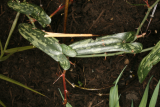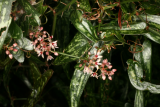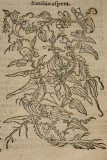Additional notes (click to expand)
Medicinal
MEDICINAL USES:
there have been many and varied claims about the therapeutic value of several Smilax species in the past 400 years, often unidentified, which continue to the present as generous beliefs unsubstantiated by preclinical or clinical evidence. Smilax spp as 'Sarsaparilla' are listed in the British Herbal Pharmacopoeia [1996] and are widely represented in the herbal and homeopathic pharmacopoeias of many other countries [Brayfield, 2014]. Preparations of the roots of several species boiled in water have been regarded as alteratives, anti-rheumatics, anti-pruritics, depuratives, diaphoretics and tonics; they are used as emetics in some countries at properly denied in others (Lindley, 1834; Christison, 1845; Flückiger and Hanbury, 1874; Tropical Plant Database; Barnes et al, 2007; Mabey R ed 1988; Winterbottom, 2015; Wild Plants of Malta). Others note their ‘acrimonious taste’ and a local narcotic action in the mouth that has been used in dentistry.
S. china, known as China Root (and other mislabelled species, including S. medicinalis and officinalis), was extensively imported to Europe as a treatment for syphilis, following the alleged beliefs of indigenous peoples of Central America [Ashburner, 1834; Lindley, 1834; Flückiger and Hanbury, 1874; Felter and Lloyd, 1898; Barnes et al, 2007; Winterbottom, 2105) but eventually fell out of fashion as its failure to cure such diseases was realised. It has also been claimed since the 17th century to be a treatment for gout by lowering the blood uric acid level. It remains in extensive use in Ayuverdic and Traditional Chinese Medicine as a 'Blood purifier' useful in rheumatism and such skin diseases as psoriasis as well as oedema, skin infections and strangury [van Wyk and Wink, 2004; Zhongzhen, 2004; Winterbottom, 2015].
Various flavonoids, glycosides, steroidal saponins, terpenes and other complex chemicals have been extracted from Smilax spp. roots and have been shown in in vitro,r in limited in vivo experiments and in weak clinical studies to display weak antibacterial, cytotoxic, uricosuric and other activities but not at concentrations that suggest potential therapeutic value [Demo et al, 1999; Barnes et al, 2007; Tropical Diseases Database]
In combinations with several other herbs ‘Sarsaparilla root (Smilax spp.) has a ‘Traditional Herbal Registration ‘ in the UK for the treatment of coughs and skin spots [British Herbal Pharmacopoeia]. It does not have such a registration in the European Union
DAYAN NOTES, 2016
Nomenclature
Smilax is the Greek name for this plant.
Stearn, W.T. (1996). Dictionary of Plant Names for Gardeners. Cassell.
Other use
NOTES ON THE GENUS:
Smilax is a genus of some 300-350 species that grow in many parts of the world from temperate to tropical zones. Some species, e.g. Smilax officinalis originate from Central and northern South America (Green, 1824; Flückiger and Hanbury, 1874) and others, notably S china and S glabra ,from SE Asia. There are about 80 species in China, many used in Traditional Chinese Medicine [Zhongzhen, 2004; Winterbottom, 2015], probably a similar number in India and about 20 in North America; the more important species commercially and medically have included S. china, S. glabra, S. officinalis and S. syphilitica. The native Jamaican variety is S. regelli and that name has also been indiscriminately applied to many North American species. The commonest species growing wild in Europe appears to be S. aspera, which, although not the most favoured for this purpose, has been used to make Sarsaparilla drinks that are more conventionally prepared from the root of S. regelli and other species. They are perennial, woody climbers, usually with thorny stems, that may form dense thickets up to 10m high. The leaves, up to 30cm long, may be streaked with white patches, the flowers range from white to pink or green and the berries are dark red.
Anthony Dayan, 2016
EARLY HISTORY
The early history and wide confusion over species identification is well described by (Lindley, 1834; Christison, 1845; Flückiger and Hanbury, 1874; Flora of North America, 2003; Winterbottom, 2015; Wild Plants of Malta). It appears that plants were introduced to Europe from Guyana and the Honduras and Peru about 1545-50 (Monardes and others cited by Flückiger and Hanbury, 1874) and that Sarsaparilla root was well used as medicine by about 1570-80. It was regarded as a treatment for rheumatic and venereal diseases, specifically including syphilis, and other infections and so became an important import into Europe from India and China as well as South America from the 17th to the later 19th centuries. Winterbottom [2015] has described how Europe became a battle ground for massive imports from China in competition with those from North and South America in the 17th-19th centuries. Eventually S china from that country and elsewhere in South Asia became the preferred source for medicinal and herbal uses in Europe and supplies from America were more often used to make Sarsaparilla [as a herbal therapy and the drink Root Beer in the USA]. The history is clouded by confusion and uncertainty over the particular species being traded and by doubts about the therapeutic value of the various species.
S glabra is also said to have been introduced from China to Goa in 1533 And there is evidence of wide knowledge of it and of its uses as an anti-infective in Islamic countries at least from the 12th century [Dymock et al, 1892]. It was imported into India from China in the 16th century and came into very wide use there in Ayuverdic medicine and in commerce; annual production in southern China in the late 19th century, mainly for export was up to 1.2 million pounds/y [Dymock et al, 1892; Winterbottom, 2015]. The therapeutic uses claimed were for the treatment of superficial infections, venereal diseases, particularly syphilis, rheumatism and fevers. Its use in gout by Charles V is mentioned although there was subsequent realisation that it was probably useless in that disease.
DAYAN NOTES, 2016
MEDICINAL USES:
there have been many and varied claims about the therapeutic value of several Smilax species in the past 400 years, often unidentified, which continue to the present as generous beliefs unsubstantiated by preclinical or clinical evidence. Smilax spp as 'Sarsaparilla' are listed in the British Herbal Pharmacopoeia [1996] and are widely represented in the herbal and homeopathic pharmacopoeias of many other countries [Brayfield, 2014]. Preparations of the roots of several species boiled in water have been regarded as alteratives, anti-rheumatics, anti-pruritics, depuratives, diaphoretics and tonics; they are used as emetics in some countries at properly denied in others (Lindley, 1834; Christison, 1845; Flückiger and Hanbury, 1874; Tropical Plant Database; Barnes et al, 2007; Mabey R ed 1988; Winterbottom, 2015; Wild Plants of Malta). Others note their ‘acrimonious taste’ and a local narcotic action in the mouth that has been used in dentistry.
S. china, known as China Root (and other mislabelled species, including S. medicinalis and officinalis), was extensively imported to Europe as a treatment for syphilis, following the alleged beliefs of indigenous peoples of Central America [Ashburner, 1834; Lindley, 1834; Flückiger and Hanbury, 1874; Felter and Lloyd, 1898; Barnes et al, 2007; Winterbottom, 2105) but eventually fell out of fashion as its failure to cure such diseases was realised. It has also been claimed since the 17th century to be a treatment for gout by lowering the blood uric acid level. It remains in extensive use in Ayuverdic and Traditional Chinese Medicine as a 'Blood purifier' useful in rheumatism and such skin diseases as psoriasis as well as oedema, skin infections and strangury [van Wyk and Wink, 2004; Zhongzhen, 2004; Winterbottom, 2015].
Various flavonoids, glycosides, steroidal saponins, terpenes and other complex chemicals have been extracted from Smilax spp. roots and have been shown in in vitro,r in limited in vivo experiments and in weak clinical studies to display weak antibacterial, cytotoxic, uricosuric and other activities but not at concentrations that suggest potential therapeutic value [Demo et al, 1999; Barnes et al, 2007; Tropical Diseases Database]
In combinations with several other herbs ‘Sarsaparilla root (Smilax spp.) has a ‘Traditional Herbal Registration ‘ in the UK for the treatment of coughs and skin spots [British Herbal Pharmacopoeia]. It does not have such a registration in the European Union.
DAYAN NOTES, 2016
USES:
According to King [1895] S officinalis is also known as S medica and S papyraceae and its root is the source of Sarsaparilla, which is said to have the same properties and medicinal uses as ‘Smilax aspera.’
An extract from the roots of some species, notably S. regelli, is used to make the soft drink Sarsaparilla and various root beers, originally in the West Indies and North America and now consumed worldwide. The root of S medica and other species was recognised in the USP as the basis of the Sarsaparilla drink in the late 19th century (Felter and Lloyd, 1898). The cooked roots, shoots and berries of local species are eaten as a food in some countries. Extracts of the leaves of S aspera contain relatively high levels of tocopherol and other antioxidants (Demo et al, 1998).
Dayan, NOTES 2016
REFERENCES
**** ****Ashburner J. 1834. Medicinal Virtues of the Smilax Aspera. London Medical Gazette, XII, 350-353.
**** ****Barnes J, Anderson LA, Phillipson JD 2007. Herbal Medicine. 3rd ed. Pharmaceutical Press, London.
**** ****Brayfield A ed 2014. Martindale. The Complete Drug Reference. 38th ed. Vol 1, P. 2610. Pharmaceutical Press, London.
**** ****British Herbal Pharmacopoeia 1996. British Herbal Medicine Association. 4th ed, P 165-6. British Herbal Medicine Association.
**** ****Christison R 1842 A dispensatory, or commentary on the pharmacopoeias of Great
Britain; comprising the natural history, description, chemistry, pharmacy,
actions, uses, and doses of the articles of the materia medica. Black, Edinburgh.
**** ****Demo A, Petrakis C, Kefalas P, Boskou D 1999. Nutrient antioxidants in some herbs and Mediterranean plant leaves. Food Res Int, 31, 351-354.
**** ****Dymock W, Warden CJH, Hooper D 1892. History of the Principal Drugs of Vegetable Origin met with in British India, Part V, Pp 500-503. London, Kegan, Paul, Trench, Turner & Co
**** ****Flückiger FA, Hanbury D. 1874. Pharmacographia : a history of the principal drugs of vegetable origin, met with in Great Britain and British India. MacMillan & Co. London.
**** ****Felter HW, Lloyd JU 1898. King’s American Dispensatory. 18th ed. Vols 1-II. Cincinnatti, Ohio Valley Co.
**** ****Flora of North America 2003. Smilax Linnaeus. 26, 1028 et seq. At http://www.efloras.org/florataxon.aspx?flora_id=1&taxon_id=10827 ; accessed 29th December 2015
**** ****King J 1895. The American Dispensatory. Ohio VALLEY Co., Cincinnatti.
**** ****Lindley J 1834. Flora Medica. Longman, London.
**** ****Mabey R ed 1988. The Complete New Herbal. Penguin, London
**** ****Tropical Plant Database. Sarsaparilla (Smilax officinalis). At http://www.rain-tree.com/sarsaparilla.htm#.VoJaiVlu3oo ; accessed 29th December 2015.
**** ****Wild Plants of Malta. Mediterranean Smilax. At http://www.maltawildplants.com/SMLX/Smilax_aspera.php ; accessed 29th December 2015
**** ****van Wyk B-E, Wink M 2004. Medicinal Plants of the World. Briza, Pretoria, RSA.
**** ****Winterbottom AE 2015. Of the China Root: A Case Study of the early Circulation of Materia Medica. Soc Hist Med, 28, 22-24
**** ****Zhongzhen Z 2004. An Illustrated Chinese Materia Medica in Hong Kong. Hong Kong Baptist University, Hong Kong.
DAYAN NOTES, 2016
Geographical distribution
- Africa, Northeast Tropical Africa, Ethiopia
- Asia-Temperate, Western Asia, Cyprus
- Asia-Temperate, Western Asia, Israel
- Asia-Temperate, Western Asia, Jordan
- Asia-Temperate, Western Asia, Lebanon-Syria
- Asia-Temperate, Western Asia, Turkey
- Asia-Tropical, Indian Subcontinent
- Europe, Southeastern Europe
- Europe, Southwestern Europe
Podcast
Smilax aspera
Family: SMILACACEAEGenus: Smilax
Species: aspera
Common names: Sarsaparilla, Rough Bindweed, Prickly Ivy
Pharmacopoeia Londinensis name: Smilax aspera, Sarzae Parigliae, Smilacis asperae
Distribution summary: S.Europe to Ethiopia & India
Habit: Perennial
Hardiness: H5 - Hardy; cold winter
Habitat: Moist woodland and riverbanks
Garden status: Currently grown
Garden location: Classical Europe & Middle East (I)
Flowering months: August, September
Reason for growing: Medicinal


.JPG)
.JPG)




.JPG)
.JPG)
.JPG)
.JPG)
.JPG)
.JPG)